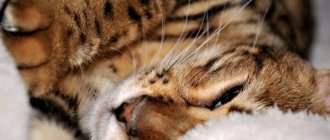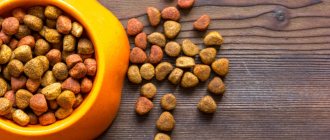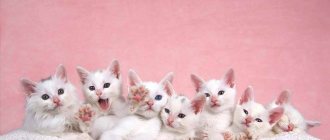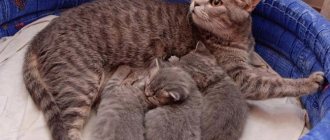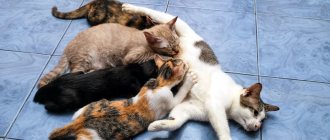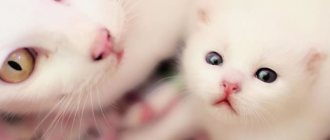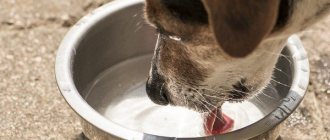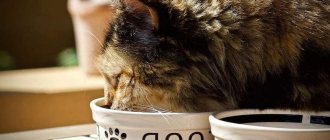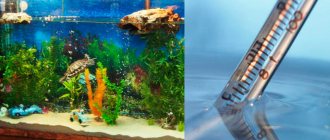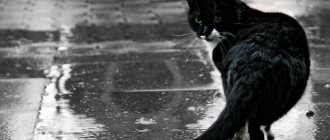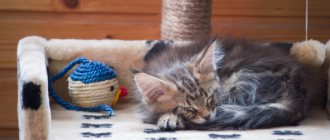A cat's body is 65% fluid. A pet's diet must include not only tasty and high-quality food, but also clean drinking water, which is of great importance for the body. Water takes part in many important life processes and helps dissolve substances entering the digestive tract.
In this article we will look at how to properly give a cat water, how much liquid a cat should be given per day, how to prepare water for drinking, methods for accustoming a cat to water, and answers to popular questions.
How much water should a cat drink per day?
Cats do not need a lot of liquid, but your pet's daily diet must include clean water. Broths and other liquid formulations cannot fully replace regular drinking water. The average daily water intake for a cat is 40-50 ml of liquid per 1 kg of weight.
If a cat eats wet food and eats other nutritious foods well, a certain portion of its daily fluid intake will enter its body. She gets the rest with drinking water. This is why the owner often thinks that the cat does not drink water at all or drinks very little.
Daily fluid intake
According to veterinarians, a cat's daily water intake should be 20-40 milliliters of water per 1 kilogram of weight. For kittens, this figure is doubled or tripled, since the growing body requires more moisture for new cells. For this reason, the diet of animals under three months of age should consist only of wet food.
The indicated rate of water consumption for a cat is average. Deviations are possible due to a number of aspects.
- Feed. If your pet eats only dry food, the amount of water it consumes should be three times the amount of pellets it eats.
- Dimensions. The lower the weight of the animal, the higher its need for fluid per 1 kilogram of body weight.
- Activity . Exclusively indoor cats are usually less active than their counterparts who periodically walk outside, and therefore drink less.
- Pregnancy and lactation. A pregnant or lactating cat needs plenty of fluids. Moisture is needed to produce additional blood, amniotic fluid and milk for kittens.
- Ambient temperature. During the hot season, cats require more fluid due to the increasing load on the thermoregulatory system. They lick themselves vigorously and, thanks to the evaporation of saliva, tolerate the heat more easily. In addition, a certain amount of liquid evaporates from the surface of the mucous membranes when a hot animal breathes with its mouth open.
What kind of water to give your cat
The health and life expectancy of a cat largely depends on the quality of drinking water. The best option for an animal is soft natural water from drinking sources. This water contains beneficial microelements for the body.
Alternatively, you can give your cat filtered or frozen water. Do not give your domestic cat water from the tap. As a rule, it is not of good quality. In addition, it may contain impurities that are dangerous to the cat’s body.
Preparation
The cat is given drinking water in a clean ceramic or glass bowl. The container must be washed daily.
Temperature
Do not give your pet too cold or hot water. The liquid should be at room temperature.
Supplements
Some owners add various additives to their cat’s water to improve the taste or quality of the drinking composition.
Water additives:
- fluorine, iodine (quality improves);
- tuna juice, anchovies (cats are attracted by the smell);
- nettle infusion (for medicinal purposes);
- special nutritional drink for cats.
Water quality and its benefits for the body
The health of cats depends, among other things, on what kind of water they drink and how much. In young animals, the water content in the body is approximately 70%. They have a faster metabolism. The cells and tissues of the body of an adult cat contain about 50% water.
Not a single vital process in the body is possible without the participation of water. It is necessary for breathing, blood circulation, digestion, and thermoregulation. Water is a solvent and helps nutrients enter cells. A lack of moisture leads to a slowdown in metabolism and provokes the development of urolithiasis. If there is a lack of fluid, the water-salt balance is disrupted and the blood becomes excessively thick.
The quality of water offered to a cat is of considerable importance. It should be given exclusively clean water. There are several options to choose from:
- Regular tap water. It is the most unsuitable due to the high content of chemical impurities and salts;
- Boiled. It brings less benefits than usual due to its poor mineral composition. In addition, during the boiling process, sediment falls out - various solid particles. Consumption of boiled water can lead to the appearance of stones in the urinary tract;
- You can leave tap water in a cool, dark place for several hours. Under these conditions, chlorine will evaporate, and other impurities will precipitate;
- Filtered water passed through any household filter is suitable for cats;
- The best option is to offer your cat store-bought drinking water bottled. It has the most balanced composition of mineral elements.
Giving an animal medicinal mineral water is dangerous to its health. It contains a high concentration of salts and carbon dioxide.
Answers on questions
Each cat is individual. Some simply drink water without creating any problems for the owner, while other representatives of the feline family are afraid of any liquid and categorically refuse to put their muzzle in a bowl so as not to wet their whiskers.
We have prepared answers to the most common questions that owners of pet cats and cats have.
The cat does not drink water: what to do
A cat's reluctance to drink water may alert the owner.
Insufficient fluid intake leads to dehydration of the body, disrupts the biochemical parameters of the blood, which in turn provokes the development of severe liver and kidney diseases. Before taking measures to correct this situation, you need to determine the reason for the cat’s refusal to drink fluids. Reasons why a cat does not drink water:
- The cat eats wet food. They contain up to 80% liquid, which is quite enough for the animal’s body.
- Reluctance to drink from an uncomfortable bowl. You can try changing the water tank to another one with wider edges, so that it is more convenient for the cat to lap up the water.
- Stale or poor quality water. Cats are very finicky and may refuse to take liquid if it does not meet their needs.
- Serious illness. As a rule, in such cases, the cat refuses not only water, but also food, or consumes it in smaller quantities, without showing much appetite. In this case, the animal needs to be shown to a veterinarian.
Try to find out the reason for the cat's refusal of water. Observe her and if you see that she drinks water from other sources, but categorically refuses to lap up the liquid from her bowl, try replacing it or placing it away from the food bowl. Some cats generally do not drink water if it is next to food.
Special additives that improve the taste and quality of the liquid will also help to accustom your cat to water. Some breeders add a pinch of soda to drinking water or throw an ice cube into a bowl of water. Cats are very curious and may become interested in water if something foreign is floating in it.
If your cat is often outside, there is a high chance that she is getting the amount of fluid she needs from outside sources. These could be ordinary puddles, which, of course, is very unsafe. In this case, the animal can only be retrained by limiting its access to the street for independent walks.
Is it normal for a cat to drink a lot of water?
Excessive water consumption is a clear sign of extreme thirst, which may indicate the development of certain diseases in the cat's body. This symptom is typical for hormonal disorders, diabetes, kidney disease, infectious diseases and febrile conditions.
If your cat drinks a lot of water and there are additional signs of her unhealthy condition, you should immediately take her to a veterinarian, who can determine the exact problem of her unhealthy interest in drinking liquids.
There is no need to worry if a cat that regularly eats dry food drinks a lot of water. With such a diet, the animal must consume a sufficient amount of liquid per day.
Can cats drink sea and salt water?
Cats located far from fresh water can quench their thirst with sea water. Their body filters salt well and removes the unnecessary element naturally. There will be no harm to your cat after drinking salt water, but you should not give it to your cat for daily drinking.
Should I give my cat mineral water?
There are times when a cat accidentally drinks mineral water from its owner’s mug and shows with all its appearance that it quite liked this liquid. Should you give your cat mineral water? Absolutely not, only in the absence of fresh water or for medicinal purposes, as prescribed by a veterinarian. If you regularly give your cat mineral water, urolithiasis may develop.
Should you give your cat boiled water?
Boiled water has a specific taste and, as a rule, cats do not particularly like it. In addition, it is completely useless for the body, so it is not recommended to give such water to a domestic cat. It is better to choose filtered, frozen or bottled water for drinking your pet.
Why does a cat move or overturn the bowl and spill water?
The cat spills water, moves the bowl - what to do? Many animals simply play with water, trying to entertain themselves with something. The reason for this behavior may also be the proximity of the food bowl. Try moving the water container to a different location.
And with this behavior, a cat may indicate the need to change stagnant water to clean and fresh. Change the fluid, not forgetting to rinse the reservoir itself thoroughly.
Watch your cat and learn to recognize her desires! Don't ignore the problem of water refusal or excessive thirst. In any unclear situation, contact your veterinarian.
How to check the amount of water you drink
Inexperienced owners worry when it seems to them that a kitten that has recently appeared in the house is not drinking enough.
You can check how much liquid your cat drinks during the day by placing bowls and other containers with water around the house and blocking any other access to water. After 24 hours, count how much water your pet drank.
This test needs to be carried out over several days, since the need to drink may change at different times. By determining the average amount of water drunk per day and comparing it with the norms, you can understand whether the kitten has been drinking enough and whether there is cause for concern.
It is better to carry out such checks several times a year.
Forced additional soldering
If there is a painful condition, the cat should be taken to the veterinarian. If a healthy pet drinks little, then dehydration of the four-legged body can be prevented by supplementing it with water.
Take a syringe with a volume of 10-20 milliliters, fill with water, and replace the needle with a silicone nozzle. To force the cat to open its mouth, place your palm on its head and press the area behind the fangs with your thumb and forefinger. When the animal opens its jaws, insert the syringe nozzle into the gap and supply water in small portions. The animal's muzzle should be slightly raised, and the syringe should be positioned at an acute angle to the head. The water should not go directly into the throat, but behind the pet’s cheek, otherwise the cat may choke. Make sure he has time to swallow. If your cat coughs, let him catch his breath.
Not all animals take this procedure calmly. If your pet actively resists and uses its claws, swaddle it in a towel, leaving only its head free.
Why is water so important to animals?
Despite the fact that up to 70% of a mammal's body consists of water, it constantly needs to be replenished from the outside. It is found in the blood, muscles, bones and is involved in the most important internal processes:
- delivers oxygen to cells;
- maintains a constant body temperature;
- lubricates joint tissues and mucous membranes;
- dissolves nutrients, facilitating the digestion and absorption of food;
- removes toxins from the body that accumulate in waste products;
- humidifies the air in the lungs.
Prolonged lack of moisture leads to a reduction in urination and increased urine concentration. This is fraught with the development of urolithiasis, cystitis and kidney pathologies. If you do not give your pet the recommended amount of fluid, he may get sick or die from dehydration.
Duphalac for children
Duphalac for infants is used in the form of syrup.
The only remedy approved by Russian pediatricians to relieve constipation in infants is Duphalac. Stool disorders are very common in children, and especially in babies in the first year of life.
Immature intestines and fragile unstable microflora are constantly at risk of imbalance between beneficial and pathogenic bacteria.
Digestive disorders, improper feeding, and poor quality food can disrupt the child’s well-being and cause constipation. The use of an enema is not advisable, since it causes reverse peristalsis and perpetuates hypotension of weak intestinal muscles.
Duphalac is not addictive, does not upset the electrolyte balance, and is not absorbed into the child’s blood. For children, especially infants, only one form of this laxative is applicable - syrup. Rules for taking Duphalac for children:
- Child from 0 to 12 months – dose is 5 ml.
- Child from one to 6 years of age - the initial dose is 10 ml, the maintenance dose is 5 ml.
- Child from 6 to 14 years old - the initial dose is 15 m. The maintenance dose is 10 ml.
It is best to take this anti-constipation remedy in the morning, immediately after a night's sleep. For infants, you can mix the required dose with milk or formula and administer the drug using a disposable syringe, after removing the needle. To achieve the best effect, you should not limit your child's fluid intake. On the contrary, it must be given in large quantities.
You can expect normalization of stool already on the second day from the start of taking the drug, although stool is possible after 2-6 hours. Any bloating should go away within 1-2 days without any additional measures. The dosage should be carefully observed to avoid side effects: diarrhea, intestinal colic. Before using Duphalac, consultation with a pediatrician is required, especially in order to eliminate constipation in infants and newborns.
About the drug
The drug Duphalac is prescribed for dysbacteriosis.
The laxative effect when taking this hyperosmotic drug is achieved by increasing intestinal motility.
Lactulose is broken down in the colon by its microflora into low molecular weight organic acids, thereby increasing the volume of intestinal contents.
Peristalsis increases, and conditions are created for emptying the colon. This restores the frequency of bowel movements and eliminates constipation.
If Duphalac is used as an adjuvant for hepatic encephalopathy or coma, it can significantly reduce the effect on the brain of toxic substances produced in the large intestine. Acting as a prebiotic, Duphalac restores the balance of intestinal microflora, suppressing the growth of pathogenic microbes such as salmonella, and promoting the growth of lacto- and bifidobacteria.
The absorption of the drug through the walls of the stomach and intestines is practically zero. It enters unchanged into the large intestine, where it is broken down by its microflora. The drug is prescribed for various diseases and conditions:
- Functional constipation.
- Hemorrhoids, operations on the intestines and anal canal (to soften hard stools).
- Hepatic encephalopathy.
- Dysbacteriosis.
- Enteritis.
- Putrid dyspepsia.
- Acute food poisoning.
- Preparation for colonoscopy, irrigoscopy, sigmoidoscopy.
This drug is not used in cases of special sensitivity to its components, as well as in cases of galactosemia and acute intestinal obstruction. Since Duphalac contains lactulose, it is used under special medical supervision for diabetes mellitus and lactose intolerance.
Reasons for drinking heavily
High-quality lactation requires more water consumption by animals.
When a kitten or adult cat absorbs a large volume of water, and there is a strong belief that he is healthy, sources of excessive fluid absorption should be sought in external factors. Dry and hot air can provoke thirst: in summer - a sun-heated room where a pet lives, in winter - a heating radiator. The reason for the increased water consumption is the cat’s pregnancy; during lactation, she also drinks a lot, since she gives the liquid with milk to the kitten.
Diet affects thirst. With dry food, you need to drink a lot of water often, since the granule must swell normally in the stomach and be digested. Therefore, in the absence of a mixed diet with the addition of canned food and pates to the diet, the cat should drink at least 400 ml per day. Eating pates and canned food also provides the pet with free access to a drinking bowl, since wet food does not cover the pet’s daily need for liquid.
